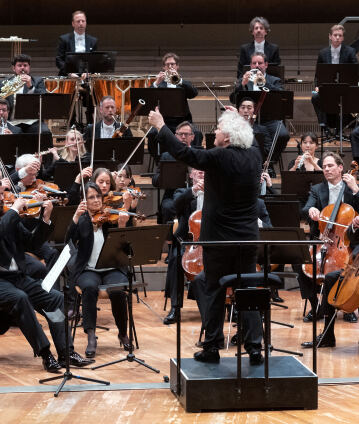Simon Rattle conducts Ginastera and Britten

A programme which allows the Berliner Philharmoniker to show off their skills as soloists: Ginastera’s Variaciones concertantes and Britten’s The Young Person’s Guide to the Orchestra offer our musicians wonderful opportunities to showcase the tonal splendour of their instruments. Principal horn Stefan Dohr and tenor Andrew Staples lead us through different nocturnal moods in Britten’s Serenade, ranging from the tender and mysterious to the menacing.
Benjamin Britten wrote numerous works for his partner, the tenor Peter Pears. This also includes the intensely atmospheric Serenade for Tenor, Horn and Strings. The work also owes its unusual instrumentation to an encounter the composer had with Dennis Brain, a horn player who impressed Britten with his virtuosity and expressiveness. In the Serenade, Britten set six poems from five centuries. As a prologue and epilogue, a horn solo frames the sung texts, which are linked by the theme of the night. William Blake’s Elegy about a disease-stricken rose is particularly haunting.
Britten wrote the Serenade during the Second World War, while The Young Person’s Guide to the Orchestra was written shortly after its end. In the both witty and brilliant variations, based on a theme by Henry Purcell, Britten first introduces the individual instruments and instrumental groups of the orchestra one after the other, and then has them compete against each other in a fugue. The Variaciones concertantes by the Argentine composer Alberto Ginastera show a similar dramaturgical progression and virtuosity in instrumentation. The work, which opens only with solo cello and harp, was performed by the Berliner Philharmoniker for the first time in this concert.
© 2021 Berlin Phil Media GmbH
Related interviews
Artists
Our recommendations
- The National Youth Orchestra of Germany with Sebastian Weigle
- Daniel Harding conducts Berlioz’s “Roméo et Juliette”
- Daniel Harding conducts Schumann’s “Scenes from Goethe’s Faust”
- Sir Simon Rattle and the Orchestra Academy perform Mahler’s “Das Lied von der Erde”
- Simon Rattle conducts Schumann’s “Paradise and the Peri”
- John Eliot Gardiner conducts Stravinsky